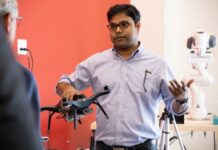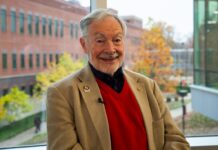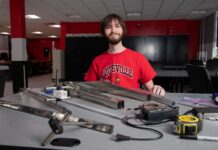With U.S. Department of Energy funding, chemical engineering professor Mahendra Sunkara and graduate student Chandrashekhar Pendyala at the UofL Conn Center for Renewable Energy Research, and professors Madhu Menon and R. Michael Sheetz at the UK Center for Computational Sciences, are leading research into using sunlight to generate hydrogen from water.
The Physical Review Journal published their findings earlier in August. (Phys Rev B 84, 075304).
Long touted as a likely key component in the transition to cleaner energy sources, pure hydrogen gas is not found in free abundance on Earth and must be manufactured by unlocking it from other compounds.
The team has found that an alloy of antimony (Sb) and gallium nitride (GaN) helps sunlight split water molecules into hydrogen and oxygen. Once they are separate, hydrogen can be collected. The process is called photoelectrochemical (PEC) water splitting.
The GaN-Sb alloy has the potential to convert solar energy into an economical, carbon-free source for hydrogen, Sunkara said.
The current process requires electricity supplied by such non-renewable sources as coal and natural gas.
“Hydrogen production now involves a large amount of carbon dioxide emissions,” Sunkara said. “Once this alloy material is widely available, it could conceivably be used to make zero-emissions fuel for powering homes and cars and to heat homes.”
Gallium nitride is a semiconductor that has been used widely since the 1990s to make bright-light LEDs. Antimony is a metalloid element that has been in increased demand in recent years for use in microelectronics.
“Previous research on PEC has focused on complex materials,” Menon said. “We decided to go against the conventional wisdom and start with some easy-to-produce materials, even if they lacked the right arrangement of electrons to meet PEC criteria. Our goal was to see if a minimal ‘tweaking’ of the electronic arrangement in these materials would accomplish the desired results.”
The alloy is the first simple, easy-to-produce material to be considered a candidate for PEC water splitting. Because it functions as a catalyst in the PEC reaction and is not consumed, the material may be reused indefinitely. The team continues to work on alloy production and testing its ability to convert solar energy to hydrogen.

























